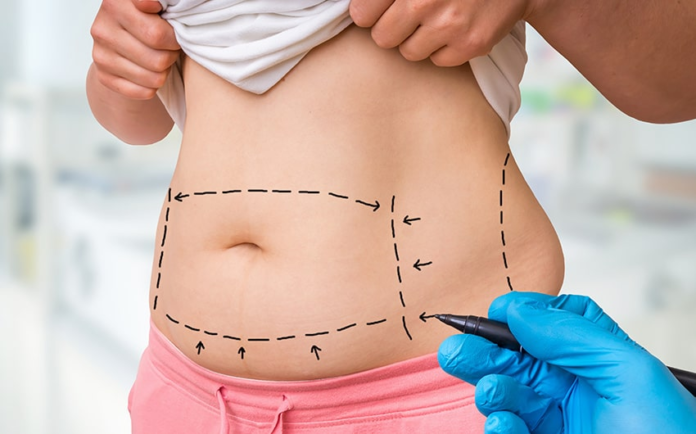Are you thinking about having liposuction on your stomach? By altering the appearance of your abdomen, this type of operation can do wonders for your body. Incorporating a healthy diet and regular exercise into your daily routine will help you achieve the best results from liposuction. Here are some things to keep in mind if you’re considering treatment.
Don’t expect a six-pack of abs:
If you’ve been envious of folks with six-pack abs in images, you might be considering having stomach liposuction done to achieve the similar look for yourself. Liposuction alone isn’t going to give you the six-pack you’ve always dreamed of.
Muscle definition is the key to a six-pack stomach. Working out, and possibly lifting weights, are necessary if you want to achieve this look. A six-pack can be achieved by having liposuction to minimize the size of your stomach, and then devising an exercise plan to build up strong abdominal muscles to get the look.
So, in short, don’t anticipate miracles and don’t expect to achieve a six-pack solely through stomach liposuction.
There are various kinds of fat:
When considering stomach liposuction as a way to slim down, keep in mind that there are two forms of fat to consider. Subcutaneous and visceral fats, respectively.
Subcutaneous fat is the jiggling, pinchable fat beneath the skin. This form of fat may not look attractive, but it is completely innocuous and sits just beneath the surface of the skin.
The “beer belly” refers to fat that has accumulated around the organs and organ systems of the body. This is not only ugly, but it is also harmful to your health.
Despite the fact that hormones are released from both forms of fat, visceral fat has a greater risk of interfering with your organs because it is so close to them. Type-2 diabetes, high blood pressure, elevated cholesterol levels, and an increased risk of stroke and heart disease can all result from this.
Subcutaneous fat is removed with liposuction, but visceral fat must be eliminated through exercise and a healthy diet.
With both visceral and subcutaneous fat in the same area, a diet and fitness regimen can be paired with liposuction.
No general anaesthesia is required for stomach liposuction:
If you’re thinking about getting your stomach liposuction done but are hesitant about undergoing general anaesthesia, consider this. However, the treatment will be performed in a tiny surgical theater without the need for general anaesthesia.
Filling the area of your stomach with saline and an anesthetic solution will numb the area during your treatment. This also helps to minimize bruising by reducing the size of the blood vessels. Additionally, the fat will be broken down by the solution.
Additionally, there is no need for a hospital stay following the treatment. After the procedure, you should be able to depart the clinic in 30 minutes or less.
Having liposuction doesn’t mean that you can’t regain the weight you lost:
One thing to keep in mind is that just because you’ve had stomach liposuction, doesn’t mean you won’t put the weight back on.
Liposuction, on the other hand, should not be regarded as a weight loss method. In order to keep a flat stomach and thin figure following the treatment, it is vital to maintain a healthy diet and exercise regiment.
During stomach liposuction, fat cells are permanently removed from the belly. Because of this, they won’t be returning. Abdominal fat will decrease by about 70% after the operation. It’s possible that if you gain weight, other parts of your body would appear larger than they would otherwise due to the liposuction reducing the size of your stomach.
Basically, stomach liposuction isn’t a quick remedy and you may gain the weight back if you don’t change your diet and exercise habits.
There is a potential for loose skin:
When it comes to stomach liposuction, your age plays a role. Collagen production in the body declines as we age, resulting in a loss of skin suppleness. Because the skin doesn’t bounce back the way it used to, this indicates that it’s less elastic.
This does not rule out the possibility of getting liposuction as you age. While this is true, it does indicate that the older a patient is when they undergo a procedure, the greater the danger of having loose or baggy skin.
Although liposuction can increase the synthesis of collagen, which is needed for suppleness, loose skin can still occur following significant weight reduction or liposuction on the stomach.
A stomach tuck may be considered in some circumstances where the abdomen is excessively big and the skin lacks flexibility.
Following therapy, use compression garments:
You must wear a compression garment for a particular period of time following your stomach liposuction. This is something your doctor will tell you about.
A Velcro binder is usually required for liposuction procedures on the stomach. In most cases, you’ll be required to wear this garment for 2 to 3 weeks after your therapy has concluded. The type of garment you’ll be asked to wear will depend on elements like your skin’s consistency, the amount of fat that was taken from the area, and the amount of edema in the area.
Getting back into a workout routine:
If you’re used to working out regularly, you’re probably wondering when you’ll be able to resume your routine after having stomach liposuction.
Exercise will help you achieve your ideal body shape and improve the quality of your liposuction outcomes. Following your treatment, it is crucial not to put yourself under too much stress too quickly.
Gentle exercise can be started within two weeks of being able to get out of bed and move around. Moderate exercise can be resumed around the four-week mark if you avoid rigorous exercises for the first several weeks. Before beginning any intense sessions, consult with your doctor. They can normally be started after six to eight weeks.































